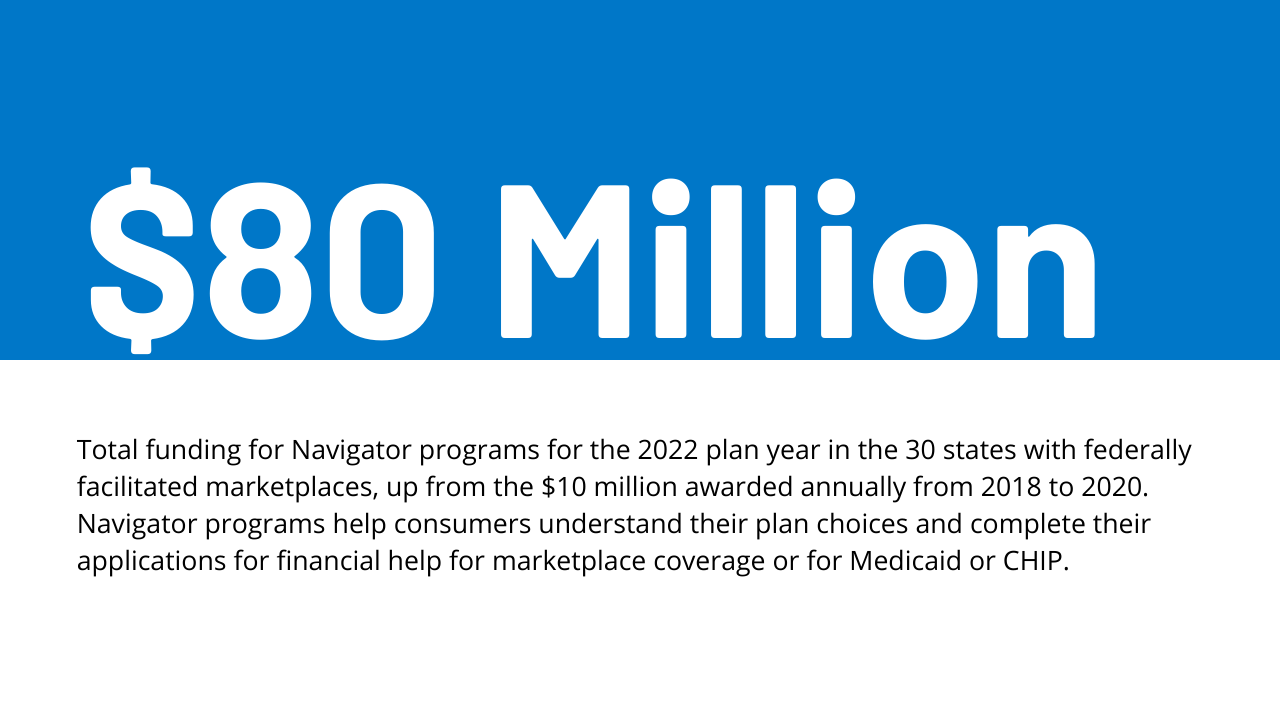Navigator Funding Restored in Federal Market States for 2022
[ad_1]
On August 27, 2021, the Centers for Medicare and Medicaid Services (CMS) announced $ 80 million in funding for 60 Navigator programs serving consumers in 30 federally facilitated market (FFM) states for the year of 2022 plan. Navigator programs help consumers understand their plan choices and complete their financial assistance application for Marketplace coverage or for Medicaid or CHIP. The multi-year award provides $ 80 million per year for 3 years; Fellows must comply with the terms of the grant to receive funding each year. Shortly after the funding announcement, CMS also finalized certain changes to regulatory standards for browsers in the federal market.
The 2021 funding is significantly higher than the $ 10 million in annual funding granted in 2018-2020 under the Trump administration and more than the $ 63 million awarded in the last year of the Obama administration. The total funding announced this year is 27% higher than the total announced in 2016, although funding changes vary widely from state to state (Table 1). Four FFM states (Georgia, Hawaii, Iowa, and South Carolina) received less funding for mariners than in 2016, while in five other states (Kansas, Montana, New Hampshire, South Dakota, and Tennessee) funding has more than doubled. In Delaware, federal funding for mariners is more than three times the 2016 total.
Increased funding will support the growth in the number of navigation programs – which had fallen to 30 by the end of the Trump administration. Compared to the first year of FFM opening, when more than 100 Navigator programs received grants, a smaller number of grantees will start working this fall; however, nearly half of FFM Navigators (29) will operate statewide programs, and most of them (20) will coordinate and share funding with a network of local partners. In contrast, in 2016, coordination between market assistant programs was more limited, although those who did so regularly said coordination was important for their effectiveness.
Federal regulatory standards for mariners previously required that there be a minimum of two mariners per state, at least one of which should be a community non-profit organization. These requirements were removed under the Trump administration and have not been reinstated. In all but two of the FFM states (Utah and Texas), every county will be included in the service area of ​​at least one navigation program and nearly one in five (19%) counties in the FFM states will be included in the service area. service area of ​​at least two programs (Figure 1). Although the funding allocations published by CMS do not indicate the type of recipient organization, it appears that almost two-thirds (38 out of 60) of marine recipients are community non-profit organizations, another 15 are providers or provider groups – federally qualified health centers, primary care associations or hospitals – and 4 are public universities, government agencies or tribal organizations. Until 2017, federal mariners were required to maintain a physical presence in their state. This requirement was also removed during the Trump administration and has not been reinstated, although CMS has encouraged grant applicants to meet this standard. One of the non-physically present beneficiaries funded during the Trump years was funded to provide state-wide services in three states in the 2022 plan year and will apparently only offer assistance by call center in the state of Iowa.
Discussion
A 2020 KFF National Consumer Assistance Survey documented a significant unmet need for registration assistance by consumers seeking coverage in the market. Since then, the COVID-19 outbreak has increased reliance on market coverage and Medicaid. Following the promulgation of grant increases and extended registration periods during the pandemic, market plan registrations increased by 2.8 million this year, including 2.1 million in states from HealthCare.gov . Newly released regulations will extend the federal market listing period for plan year 2022 from 6 weeks to 8 weeks (November 1 to January 15) and allow individuals with incomes up to 150% of the threshold. federal poverty rate (or $ 19,320 for an individual in 2021) to enroll throughout the year. Assuming the public health emergency ends in 2022, the Medicaid opt-out moratorium will be lifted and many more low-income people may have to switch to market plans if their Medicaid eligibility is terminated. The restoration of federal funding to mariners comes at a time when the need for consumer assistance may reach new, higher levels.
In addition to increasing funding for browsers, ensuring consumers know that browser help is available and where to find it can help improve access to registration help. In recent years, CMS has taken various steps to facilitate consumer access to agents and brokers, including an “On-Demand Help†feature of HealthCare.gov that connects individual consumers directly with brokers. CMS has also encouraged the use of web-based brokerage sites, called Enhanced Direct Enrollment Entities (EDEs), which offer online dashboards and other technology tools to make broker-assisted registrations faster and smoother. effective. No comparable initiative has been undertaken to promote and facilitate registration assistance by market browsers. Since CMS amassed over $ 1 billion in unspent Marketplace User Fee revenue during the Trump administration, additional resources are available to increase enrollment assistance support if needed.
[ad_2]

